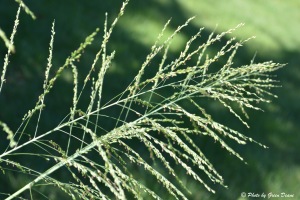Panicum maximum and then some
I eat grass. Actually we all do — rice, wheat, oats, barley — but my local trail nibble is Guinea Grass, a relative to millet. I’d like to tell you I collect enough to bake a loaf of bread, but I don’t. It’s an extremely common small-seeded grass here in Central Florida, unlike say Barn Yard Grass, and offers itself as a supplement to ones diet. On the trail I strip a stalk and just chow it down raw (making sure it is not purple or red or black or brown with fuzzy ergot.) Or, I gather a few cups and parch the seeds till lightly green/brown and then snack on them. No, I don’t winnow them. It has a slightly burnt peanut flavor, quite nice actually.
Relatives of Panicum maximum provide a lot of food around the world. You will find grasses among the most difficult foragables to sort out. There are few quality references and grasses are frustratingly alike. Fortunately, there are just a few poisonous grasses but one you do have to look out for in North America is Johnson Grass, Sorghum halepense. Its leaves are toxic to humans. The Andropogons are iffy, too. Panicum maximum PAN-ih-kum MAK-see-mum) means “big bread.” Millet is not an important grain source in the United States but it very common in the rest of the world. I suspect the seeds of most Panicums are edible.
This just in: This plant’s new name is Megathyrsus maximum… which means “Big Flower Stem.” I hope that nomenclature update makes things much, much clearer.
Green Deane’s “Itemized” Plant Profile
IDENTIFICATION: Panicum maximum is a perennial with a short, creeping rhizome, height to seven feet. Leaf sheaths at the bases of the stems are covered in fine hairs. Blades are up to 1.5 inches wide, tapering to a long fine point. Inflorescence is a large multi-branched, open panicle with loose, flexible branches. The lower branches in a whorl. Spikelets are green to light purple. Usually in large stands.
TIME OF YEAR: Flowers from November to July, seeds in fall.
ENVIRONMENT: Prefers fertile soil, adapted to a wide variety of conditions. Grows well in shade, damp area, under trees, seen along rivers and open woodland.
METHOD OF PREPARATION: I eat them as a trail side nibble raw off the stalk, or parch them and eat without winnowing. Experiment.





It’s extremely common here in Florida. Someone who does sell seeds is Andy Firk. You can find him on facebook.
You mentioned that there were poisonous grasses that look like this, but how can you tell the difference?
Study.
Director Esquire
We are working on the import of seeds in Riyadh.ksa
We want to import PANICUM MAXIMUM
How is the piece and the price
Thank you
We have 1000s of acres of panicum maximum here on Hawaii island. Some “smart” person brought it here for animal forage, but it gives cows and horses gastric distress so they don’t eat it. It grows with vigor to 12 feet tall, and is razor sharp. We call it sword grass. It’s also extremely pernicious, and has almost created a monoculture, drowning out all the other pernicious weeds here. You can’t get rid of it, so I was hoping I could use it as a food source. It has these large, lovely looking forms on them….hope they are edible…
PLEASE DO NOT PLANT THIS. You can find many other native species to plant/forage. Megathyrsus maximus is a listed invasive species to Florida which displaces many native grasses.
PLEASE DO NOT PLANT THIS. You can find many other native species to plant/forage. Megathyrsus maximus is a listed invasive species to Florida which displaces many native grasses.